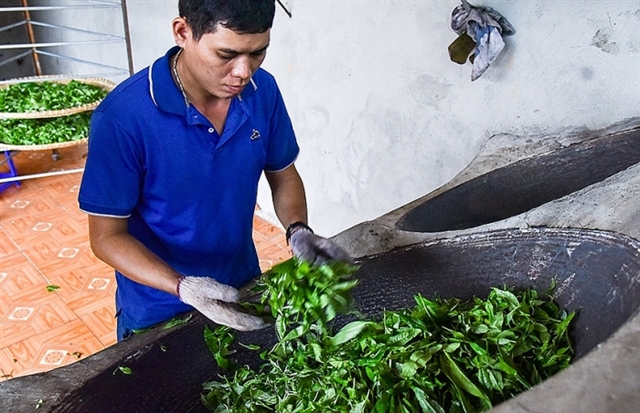 Society
Society

Now, the 34-year-old uses social media to run his family’s traditional tea business.

|
| Hoàng Tinh Kiêm roasts tea leaves using traditional method. — Photo courtesy of Nguyễn Thị Hồng |
Khánh Vân
HÀ GIANG — Three years ago, Hoàng Tinh Kiêm, a Dao ethnicity man in northern mountainous Hà Giang Province, knew little about social network platforms like Facebook and Zalo.
But now, the 34-year-old uses social media to run his family’s traditional tea business.
Generations of Kiêm’s family in Vị Xuyên District’s Cao Bồ Commune have made a living by processing and selling tea for years.
“The tea trees have existed for a long time before I was born. Some trees are 200-500 years old,” he said.
“As a special gift from nature, we have processed and sold tea to earn a living, from generation to generation,” he said.
However, traditional tea processing and selling brought little profit, prompting the young man to find ways to develop his family business.
“I have joined training courses held by local authorities on farming techniques and doing business to develop our business,” Kiêm said.
“While doing business with others, I learned how they had successfully used Facebook and Zalo to sell their products,” he said.
“And I decided to give it a try,” he said.
Joining these social platforms, the young man made friends with people from different localities which created chances for him to introduce his tea products to a wide range of customers.
“I usually post photos about ancient tea trees and tea fields of Hà Giang as well as traditional tea processing steps and tea products, which gradually drew attention from people. Then some people started to text me to ask about my products and I received the first orders via those platforms,” he said.
However, the online business was not as easy as he had imagined.
“At first, not so many people believed in the quality of the products I introduced on my social platforms. The images were not enough. And I got no orders for the first several months,” he said.
“Then I decided to send samples of my tea products for them to try. And gradually, more and more customers came to me,” he added.
“The business has started to work effectively but more needs to be done to expand it,” he said.
Challenges remain, particularly his lack of experience in processing different kinds of tea to make diverse products and meet consumer demand, according to Kiêm.
Investment in expanding tea processing workshops and modern processing technology and equipment is also needed. Most local farmers still use traditional tea processing methods with low productivity.
He was reminded of years before when most local farmers sold raw materials to traders, including those from China, with low price, due to limited knowledge about tea processing.
To help tackle such issues, Kiêm has formed a co-operative of young local farmers to share experience and support each other. The group has drawn 10 households in the village, most of them poor families.
“We share experience in tea processing and expanding markets and find ways to improve the products’ quality,” he said.
They have also participated in training classes hosted by local authorities and engaged in organic farming to raise tea quality.
Organic farming
Lý Quốc Hưng, chairman of People’s Committee of Cao Bồ Commune, said the local government has worked with village elders to encourage local farmers to use organic cultivation to help raise tea value.
“We have held regular training classes on organic methods, farming and processing techniques to help local farmers raise tea quality,” he said.
Local farmers previously didn't consider tea trees as major farm produce so they paid little attention to the trees’ quality, according to Hưng.
But they have gradually changed to organic farming and tea growth and production has become a key source of income for many ethnic minority households in the commune, he said.
Kiêm said: “We knew nothing about expanding markets and had no understanding of organic farming before so the tea production and price were so low.”
“But now the tea quality has improved with more diverse products, it also means tea price has increased and is more stable,” he said.
Chairman Hưng said: “Cao Bồ Commune has become a favourite tea production area of customers not only in Việt Nam but also from other countries. There are times we can't meet export demand.”
In the first six months of 2019, farmers in the commune harvested nearly 200 tonnes of tea buds with an estimated value of VNĐ10 billion ($432,000).
The commune exports nearly 200 tonnes of organic tea products to many countries each year, mostly in Europe and America.
Endowed with good conditions for tea production, Hà Giang has identified tea as a way to help local ethnic minorities improve their livelihoods.
The province is the third largest tea-growing area in Việt Nam, with 20,000ha of tea with an annual output of over 73,000 tonnes of tea buds per year. Of which, more than 9,000ha is certified to meet VietGAP and organic standards.

|
| Farmers pick tea buds in northern mountainous Hà Giang Province. — VNA/VNS Photo Nguyễn Chiến |
And with the determination and efforts of both local authorities and farmers, tea production has made many once poor ethnic farmers in the province successful businessmen like Kiêm.
His tea products are not only sold to customers in Việt Nam but also those from other countries like China, Laos and Russia. Kiêm has exported dozens of tonnes of organic tea products and has provided for his family.
Each month, his family can earn an average of VNĐ10-12million (US$430-520) from tea production.
They had never thought of escaping poverty, not to mention earning a mint from the tea trees.
Kiêm said doing online business and organic farming were all new, but it was worth learning and trying. — VNS




